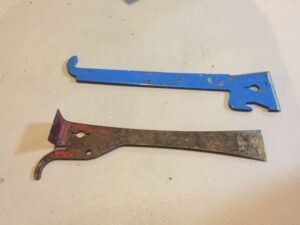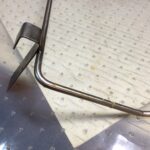For most beekeepers, what to get us as a gift is easy—bees. Like chocolate and money, you can probably never have too many. But, if your budget or backyard don’t allow you to get more bees for your favorite beekeeper, here are a few other gift suggestions.
One of the two things that I ALWAYS have when working bees (beyond Hubby and my protective suit) is the Kent Williams hive tool–the reddish, well-worn one pictured. No other j-hook hive tools that I’ve found compare (sure, the blue one has a hook … but it doesn’t compare.) To me, the key feature is the perpendicular pry bar edge (on the left of its photo.) That allows you to hook a frame with the wonderfully long hook, and then leverage the frame out using the side of the hive body. It also is tapered from the right end well up the shaft; most j-hooks are only tapered a quarter-inch or so. The longer hook is also helpful when wrestling a well-propolized frame. Just google ‘Kent Williams hive tool’ — lots of places carry them. Other than the hive tool not coming to me when I call it (after I have of course misplaced it), it is PERFECT.
The second thing I never work bees without (weather permitting) is a squirt bottle. This photo features many things — like my crazy husband who feels that pants are over-rated and often works bees in shorts. In the foreground is our beloved squirt bottle.
I recommend a heavy-duty squirt bottle – less than $5. The dollar store versions work OK for a few months, but when you drop them they snap easily … so spend the big bucks and get something a bit more rugged.
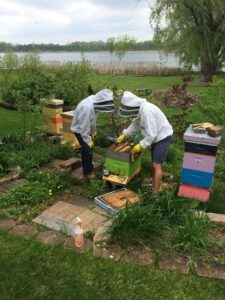
Guess who got stung on the leg seven times this outing? No, not the man in shorts–me. Like I needed bigger thighs!
We use a squirt bottle of 1:1 sugar syrup practically every time we work bees, because:
-I want them to remember me as the sugar fairy who brings them sweet drinks, not as the smoke threat who disorients them
-The syrup spritz focuses them elsewhere (ie, licking each other and residual syrup on the frames) instead of worrying about the person opening the hive
-Because they’re licking syrup off themselves, they’re potentially grooming (and removing) some mites
-It is a refreshing drink on a summer’s day
You can’t spritz when it is cool (less than about 50 degrees as a guideline) because you might chill any brood, so the squirt bottle has been stored away for the season. And, we do use smoke when a hive is cranky, as well as when we’re robbing honey. But for 90% of our hive checks, we just squirt a sweet hello at the front entrance, and then spritz lightly each hive body and most frames as we work our way through.
A third thing I’d recommend: a beekeeping jacket. Even if your beekeeper already has one, another set of protective wear allows them to share the joy of hanging out with honeybees with another person. (You?)
With a jacket on top, and floppy, tucked-in pants on the bottom, the wearer is well-protected. Purchase an XL or larger to fit most potential hive tourists. Loose-fitting is important–bees can sting through a protective suit IF they want to and IF they can get a good grip on the fabric.
Chances are your beekeeper started out with a full protective suit. It seems safer and more secure. But, as a person works with stinging insects and discovers they really don’t want to sting—as well as discovers that the sting hurts terribly for a bit but that the intense pain passes, (using profanity often helps)—beekeeping in a jacket has appeal. It is cooler and easier to put on.
There are lots of headpiece options in jackets, and lots of different features (zip versus pullover, thumb hooks or not, a waist tie should an angry bee find its way up through the bottom, etc.) Most options and features are individual preference. With jackets generally priced $55 – $75, if your beekeeper develops a strong preference for a different style hood or feature for example, you can always buy another jacket down the road … and now you’ve got another protective suit for when your neighbor and her brother want to see what’s in those pretty buzzing boxes in your backyard.
Number four? The Kalamazoo Bee Club’s bee school, February 20th of next year. Whether you’re a wanna-bee, a relative newbee, or even experienced, you’ll find something of interest with our multitude of speakers and topics. You can learn more about it at their site.
Another favorite? A frame rack. For years I set my frames on the ground. Sure, one end got sandy and grassy, and sure, lots of bees crawled off and got stepped on or crawled up my pant leg when I didn’t tuck my pants in well, but I didn’t know better. And now, I have one of these for every bee yard as I hate working bees without it. The picture shows how you can hang it from a box (deep, shallow, medium, nuc – doesn’t matter) and place the first few frames you remove on it.
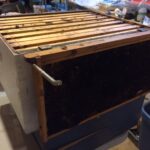
Yes, I had to stage this photo. Sorry there are no bees helping me demo it, but they’re all clustered around their queen now that the weather is finally more appropriate for December.
There are a couple different styles, but this is the one we prefer. Please notice the shortened inverted U that holds the rack on the hive body—it is about two inches. We had some that had about a five-inch length, and they weren’t as efficient to get on and off easily, and a few more bees had to be disrupted when we put it on. If that’s the only model you can locate, that’s fine. Those are glorious also, although we’ve shortened all of ours that were longer. The key feature to find is sturdiness. A full frame of honey is fairly heavy, so you don’t want a rack that bends under that weight.
A MUST-HAVE (all modesty aside) is a copy of my book: Whether you’re a beekeeper, a nature lover, or just someone who could use a laugh, this is a book you’ll enjoy. It’s been out over a year, and all modesty aside again—I’ve received some radiant testimonials about how fun, enlightening and uplifting it is. And, the price is right: $10 (plus shipping.) If you let me know real soon that you want an autographed copy (either through FB or through my website www.hubbardhive.com), I’ll get it in the mail the next day. By the way—all profits go to my late husband’s favorite charities that feed the hungry in SW Michigan. Loaves & Fishes and Meals on Wheels have received thousands of dollars over the years from sales of this book and honey.
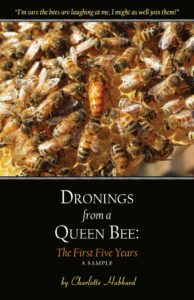 A queen clip: This is a $4-$5 plastic clip cage that looks like a fat banana hair clip. They’re wonderful for the seemingly rare occasions when you find the queen right away, and you don’t want to worry about her while you’re working the hive. We carry it in our tool bucket. If we see her, we’ll grab it and safely enclose her majesty until we’re done working that colony. A much bee-loved queen (pun intended) will have the clip covered with bees within seconds of you capturing her—as shown in the photo.
A queen clip: This is a $4-$5 plastic clip cage that looks like a fat banana hair clip. They’re wonderful for the seemingly rare occasions when you find the queen right away, and you don’t want to worry about her while you’re working the hive. We carry it in our tool bucket. If we see her, we’ll grab it and safely enclose her majesty until we’re done working that colony. A much bee-loved queen (pun intended) will have the clip covered with bees within seconds of you capturing her—as shown in the photo.

